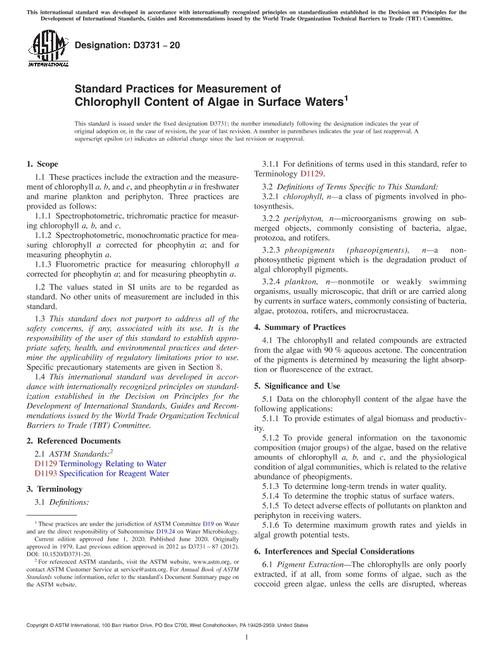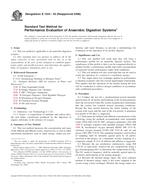-
-
Available Formats
- Options
- Availability
- Priced From ( in USD )
-
Available Formats
-
- Immediate download
- $65.00
- Add to Cart
-
- Printed Edition
- Ships in 1-2 business days
- $65.00
- Add to Cart
Customers Who Bought This Also Bought
-

ASTM E895-89(2008)
Priced From $60.00 -

ASTM D3731-20
Priced From $50.00 -

ASTM E1358-97(2019)
Priced From $42.00 -

ASTM E1535-93(2006)
Priced From $50.00
About This Item
Full Description
1.1 This guide describes procedures for obtaining laboratory data concerning the adverse effects of a test material added to dilution water, but not to food, on certain species of saltwater mysids during continuous exposure from immediately after birth until after the beginning of reproduction using the flow-through technique. These procedures will probably be useful for conducting life-cycle toxicity tests with other species of mysids, although modifications might be necessary.
1.2 Other modifications of these procedures might be justified by special needs or circumstances. Although using appropriate procedures is more important than following prescribed procedures, results of tests conducted using unusual procedures are not likely to be comparable to results of many other tests. Comparison of results obtained using modified and unmodified versions of these procedures might provide useful information on new concepts and procedures for conducting life-cycle toxicity tests with saltwater mysids.
1.3 These procedures are applicable to all chemicals, either individually or in formulations, commercial products, or known mixtures, that can be measured accurately at the necessary concentrations in water. With appropriate modifications, these procedures can be used to conduct tests on temperature, dissolved oxygen, and pH and on such materials as aqueous effluents (see also Guide E 1192), leachates, oils, particulate matter, sediments, and surface waters.
1.4 This guide is arranged as follows:
| Section | |
| Referenced Documents | 2 |
| Terminology | 3 |
| Summary of Guide | 4 |
| Significance and Use | 5 |
| Hazards | 7 |
| Apparatus | 6 |
| Facilities | 6.1 |
| Construction Materials | 6.2 |
| Metering System | 6.3 |
| Test Chambers | 6.4 |
| Cleaning | 6.5 |
| Acceptability | 6.6 |
| Dilution Water | 8 |
| Requirements | 8.1 |
| Source | 8.2 |
| Treatment | 8.3 |
| Characterization | 8.4 |
| Test Material | 9 |
| General | 9.1 |
| Stock Solution | 9.2 |
| Test Concentration(s) | 9.3 |
| Test Organisms | 10 |
| Species | 10.1 |
| Age | 10.2 |
| Source | 10.3 |
| Brood Stock | 10.4 |
| Food | 10.5 |
| Handling | 10.6 |
| Harvesting Young | 10.7 |
| Quality | 10.8 |
| Procedure | 11 |
| Experimental Design | 11.1 |
| Dissolved Oxygen | 11.2 |
| Temperature | 11.3 |
| Beginning the Test | 11.4 |
| Feeding | 11.5 |
| Cleaning | 11.6 |
| Duration of Test | 11.7 |
| Biological Data | 11.8 |
| Other Measurements | 11.9 |
| Analytical Methodology | 12 |
| Acceptability of Test | 13 |
| Calculation | 14 |
| Documentation | 15 |
| Keywords | 16 |
| Appendix | |
| X1. Statistical Guidance | |
1.5 This standard does not purport to address all of the safety concerns, if any, associated with its use. It is the responsibility of the user of this standard to establish appropriate safety and health practices and determine the applicability of regulatory limitations prior to use. Specific hazard statements are given in Section 7.
Document History
-
ASTM E1191-03A(2023)e1
Standard Guide for Conducting Life-Cycle Toxicity Tests with Saltwater Mysids- Most Recent
-
ASTM E1191-03a(2023)
Standard Guide for Conducting Life-Cycle Toxicity Tests with Saltwater Mysids- Historical Version
-
ASTM E1191-03a(2014)
Standard Guide for Conducting Life-Cycle Toxicity Tests with Saltwater Mysids- Historical Version
-
ASTM E1191-03a(2008)
currently
viewing
Standard Guide for Conducting Life-Cycle Toxicity Tests with Saltwater Mysids- Historical Version
-
ASTM E1191-03a
Standard Guide for Conducting Life-Cycle Toxicity Tests with Saltwater Mysids- Historical Version
-
ASTM E1191-03
Standard Guide for Conducting Life-Cycle Toxicity Tests with Saltwater Mysids- Historical Version
-
ASTM E1191-97
Standard Guide for Conducting Life-Cycle Toxicity Tests with Saltwater Mysids- Historical Version





